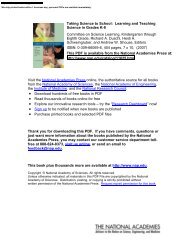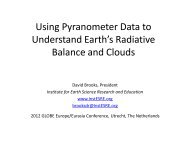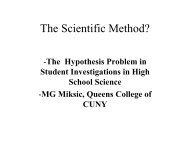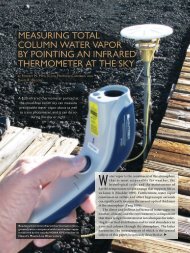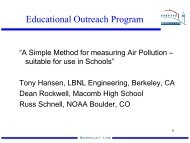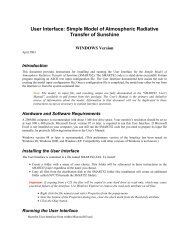Estimating Cloud Type from Pyranometer Observations - American ...
Estimating Cloud Type from Pyranometer Observations - American ...
Estimating Cloud Type from Pyranometer Observations - American ...
Create successful ePaper yourself
Turn your PDF publications into a flip-book with our unique Google optimized e-Paper software.
JANUARY 1999 DUCHON AND O’MALLEY<br />
137<br />
FIG. 7. Numerical differences between modeled and measured<br />
clear-sky irradiance for the days in Fig. 6.<br />
modeled and measured clear-sky irradiance for the same<br />
days as in Fig. 6. It is apparent that there is an uncertainty<br />
of about 30 W m 2 in the clear-sky model relative<br />
to the pyranometer observations that is independent<br />
of zenith angle. Model minus measured differences<br />
are most likely due to using a constant aerosol transmission<br />
coefficient, surface dewpoint as a proxy of total<br />
column water vapor, and an inexact seasonal parameter<br />
[see Eq. (5)].<br />
5. Comparison of pyranometer cloud-type<br />
estimation with human observations<br />
a. Background<br />
It must be recognized at the outset that in comparing<br />
cloud types <strong>from</strong> a pyranometer with those <strong>from</strong> human<br />
observations, the methods of measurement are fundamentally<br />
different. In the latter, the entire sky or at least<br />
a sizable portion is viewed at a moment in time; in the<br />
former, the estimation is weighted toward the solid angle<br />
traversed by clouds passing through the solar beam over<br />
a period of time (21 min). Nevertheless, if one or more<br />
cloud types are approximately uniformly distributed<br />
across the sky, there should be good correspondence<br />
between the two methods. We can anticipate that there<br />
will be times when, for example, widely scattered cumulus<br />
do not interrupt the solar beam, resulting in the<br />
pyranometer method underestimating the occurrence of<br />
cumulus. In fact, since human cloud observations are<br />
based on a large fraction or the totality of the sky, the<br />
pyranometer method, in general, will underestimate<br />
cloudiness determined by the human method.<br />
One means to assess the efficacy of the pyranometer<br />
method of cloud classification is by comparing cloud<br />
types produced <strong>from</strong> the pyranometer with those <strong>from</strong><br />
human observations. Human observations are taken by<br />
the central facility operator, who records cloud types<br />
and height using the World Meteorological Organization<br />
cloud-type-code for each quadrant of the sky (NE, SE,<br />
SW, and NW) at the beginning of each hour on weekdays<br />
during most daylight hours. Given that the sun is always<br />
located in the southern half of the sky at the central<br />
facility, the comparisons were made in the SE quadrant<br />
before solar noon and in the SW quadrant following<br />
solar noon. Table 1 provides the connection between the<br />
objective determination of cloud type and human observations.<br />
For example, if the observer notes any type<br />
of high cloud between 0.1 and total coverage, and the<br />
objective method yields cirrus, a ‘‘correct’’ decision is<br />
declared. Similarly, a correct decision is made if the<br />
observer records any low or midlevel clouds covering<br />
0.9 or 1.0 coverage and the objective method indicates<br />
stratus. The terms ‘‘correct’’ and ‘‘incorrect’’ are used<br />
in the sense of having a match or not of the left side to<br />
the right side of Table 1. That is, human observations<br />
are used as the reference, but since they are subjective,<br />
different observers can classify similar clouds differently.<br />
b. Comparisons among no clouds, cirrus,<br />
cumulus, and cirrus and cumulus<br />
Contingency Tables 2–4 provide a representative selection<br />
of monthly cloud-type classification comparisons<br />
for 1995. If there was always a one-to-one correspondence,<br />
then the values of all the off-diagonal el-<br />
TABLE 2. Contingency table showing comparison of cloud type estimated by pyranometer method vs cloud type<br />
<strong>from</strong> human observations for January 1995.<br />
<strong>Cloud</strong> type <strong>from</strong> human observation<br />
No clouds<br />
22<br />
Cirrus and<br />
2<br />
Cumulus<br />
6<br />
Cirrus and cumulus<br />
7<br />
Stratus<br />
0<br />
Precipitation–fog<br />
0<br />
Other<br />
0<br />
No<br />
clouds Cirrus Cumulus<br />
3<br />
5<br />
11<br />
4<br />
0<br />
0<br />
0<br />
<strong>Cloud</strong> type <strong>from</strong> pyranometer method<br />
0<br />
0<br />
8<br />
11<br />
0<br />
0<br />
1<br />
Cirrus and<br />
cumulus<br />
0<br />
0<br />
8<br />
7<br />
3<br />
0<br />
0<br />
Stratus<br />
0<br />
0<br />
6<br />
0<br />
21<br />
3<br />
0<br />
Precipitation–<br />
fog<br />
0<br />
0<br />
0<br />
0<br />
0<br />
4<br />
0<br />
Other<br />
0<br />
0<br />
11<br />
2<br />
12<br />
6<br />
4




